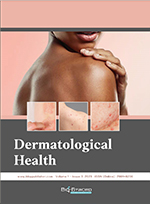Abstract
Talaromycosis is the most common opportunistic fungal infection in AIDS (acquired immunodeficiency syndrome) patients and its causative agent, Talaromyces marneffei, is endemic in Southeast Asia and southern China. However, in recent years, there has been an increasing number of reports of Talaromyces marneffei infection in nonendemic areas around the world, and incidences of infection in HIV (human immunodeficiency virus)-negative patients have also seen an upward trend. Mycobacterium tuberculosis, which causes human tuberculosis, not only invades the lungs but can travel with cells and lymph, and subsequently invade the whole body. Tuberculosis and Talaromyces marneffei share similar clinical manifestations, making them prone to being overlooked or misdiagnosed. This article reports a case of an HIV-negative patient who was repeatedly misdiagnosed with cervical lymph node tuberculosis and pulmonary tuberculosis. The symptoms did not improve after several months of treatment. After a series of diagnostic methods such as matrix-assisted laser desorption ionization time-of-flight (MALDI-TOF) mass spectrometry, galactomannan (GM) test, fungal microscopy, and fungal culture, the patient was finally diagnosed with Talaromyces marneffei infection. This case report is intended to serve as a reference for clinicians to reduce missed diagnoses and misdiagnoses.
References
Cao C, Xi L, Chaturvedi V, 2019, Talaromycosis (Penicilliosis) Due to Talaromyces (Penicillium) marneffei: Insights into the Clinical Trends of a Major Fungal Disease 60 Years After the Discovery of the Pathogen. Mycopathologia, 184(6): 709–720.
Gilbert DN, Chambers HF, Saag MS, et al., 2020, The Sanford Guide to Antimicrobial Therapy 2020 (50th Edition), Antimicrobial Therapy, Inc., Virginia, 140.
Jr Cooper CR, McGinnis MR, 1997, Pathology of Penicillium marneffei. An Emerging Acquired Immunodeficiency Syndrome-Related Pathogen. Arch. Pathol. Lab. Med., 1997(121): 798–804.
Supparatpinyo K, Nelson KE, Merz WG, et al., 1993, Response to Antifungal Therapy by Human Immunodeficiency Virus-Infected Patients with Disseminated Penicillium marneffei Infections and In Vitro Susceptibilities of Isolates from Clinical Specimens. Antimicrob Agents Chemother, 37(11): 2407–2411.
Ning C, Lai J, Wei W, et al., 2018, Accuracy of Rapid Diagnosis of Talaromyces marneffei: A Systematic Review and Meta-Analysis. PLoS ONE, 13(4): e0195569. http://doi.org/10.1371/journal.pone.0195569
Dorman SE, 2018, Diagnosis of HIV-Associated Tuberculosis. Curr Opin HIV AIDS, 13(6): 462–468.
Qiu Y, Pan M, Yang Z, et al., 2022, Talaromyces marneffei and Mycobacterium tuberculosis Co-Infection in a Patient with High Titer Anti-Interferon-? Autoantibodies: A Case Report. BMC Infect Dis, 22(1): 98.
Thompson GR 3rd, Le T, Chindamporn A, et al., 2021, Global Guideline for the Diagnosis and Management of the Endemic Mycoses: An Initiative of the European Confederation of Medical Mycology in Cooperation with the International Society for Human and Animal Mycology. Lancet Infect Dis, 21(12): e36–e374.
Hu Y, Zhang J, Li X, et al., 2013, Penicillium marneffei Infection: An Emerging Disease in Mainland China.Mycopathologia, 175(1–2): 57–67.
He L, Mei X, Lu S, et al., 2021, Talaromyces marneffei Infection in Non-HIV-Infected Patients in Mainland China. Mycoses, 64(10): 1170–1176.
Chan JF, Lau SK, Yuen KY, et al., 2016, Talaromyces (Penicillium) marneffei Infection in Non-HIV-Infected Patients. Emerg Microbes Infect, 5(3): e19.
Guo J, Ning XQ, Ding JY, et al., 2020, Anti-IFN-Gamma Autoantibodies Underlie Disseminated Talaromyces marneffei Infections. J Exp Med, 217(12): e20190502.
Hoflich C, Sabat R, Rosseau S, et al., 2004, Naturally Occurring Anti-IFN-Gamma Autoantibody and Severe Infections with Mycobacterium cheloneae and Burkholderia cocovenenans. Blood, 103(2): 673–675.
Oki A, Sakagami T, Yoshizawa K, et al., 2018, Clinical Significance of Interferon-? Neutralizing Autoantibodies Against Disseminated Nontuberculous Mycobacterial Disease. Clin Infect Dis, 66(8): 1239–1245.
Shih HP, Ding JY, Yeh CF, et al., 2021, Anti-Interferon-?-Autoantibody-Associated Immunodeficiency. Curr Opin Immunol, 2021(72): 206–214.
Browne SK, Burbelo PD, Chetchotisakd P, et al., 2012, Adult-Onset Immunodeficiency in Thailand and Taiwan. N Engl J Med, 367(8): 725–734.
Qiu Y, Huang J, Li Y, et al., 2021, Talaromyces marneffei and Nontuberculous Mycobacteria Co-Infection in HIV-Negative Patients. Sci Rep, 11(1): 16177–16186.
Shima K, Sakagami T, Tanabe Y, et al., 2014, Novel Assay to Detect Increased Level of Neutralizing Anti-Interferon Gamma Autoantibodies in Non-Tuberculous Mycobacterial Patients. J Infect Chemother, 20(1): 52–56.
Yoshizawa K, Aoki A, Shima K, et al., 2020, Serum Anti-Interferon-? Autoantibody Titer as a Potential Biomarker of Disseminated Non-Tuberculous Mycobacterial Infection. J Clin Immunol, 40(2): 399–405.
Qiu Y, Feng X, Zeng W, et al., 2021, Immunodeficiency Disease Spectrum in HIV-Negative Individuals with Talaromycosis. J Clin Immunol, 41(1): 221–223.
Huang YT, Hung CC, Liao CH, et al., 2007, Detection of Circulating Galactomannan in Serum Samples for Diagnosis of Penicillium marneffei Infection and Cryptococcosis Among Patients Infected with Human Immunodeficiency Virus. J Clin Microbiol. 45(9): 2858–2862.
Passos AIM, Dertkigil RP, Ramos MC, et al., 2017, Serum Markers as an Aid in the Diagnosis of Pulmonary Fungal Infections in AIDS Patients. Braz J Infect Dis., 21(6): 606–612.
Fang L, Liu M, Huang C, et al., 2022, MALDI-TOF MS-Based Clustering and Antifungal Susceptibility Tests of Talaromyces marneffei Isolates from Fujian and Guangxi (China). Infect Drug Resist., 2022(15): 3449–3457.
